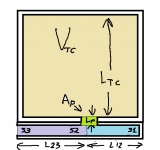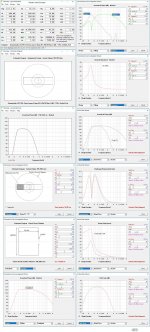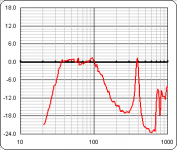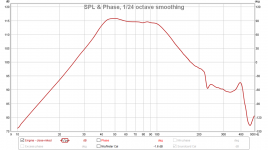Hi
I have a question about a different design of a bas reflex port.
Will a bas port that goes all the way from the front to the rear of the cabinet, with the hole somewhere along the port work?
And how to calculate it.
As I see it the tuning frequency will depend a lot on how far away from the opening the internal hole is.
best regards
uwe
I have a question about a different design of a bas reflex port.
Will a bas port that goes all the way from the front to the rear of the cabinet, with the hole somewhere along the port work?
And how to calculate it.
As I see it the tuning frequency will depend a lot on how far away from the opening the internal hole is.
best regards
uwe
Hole must be precisely in the middle. Put in the calculator half of the whole tube length minus half of the hole.
I have to ask - why this unnecessary complication ("unorthodox" is not the best word to describe it)? If you insist on this, the best solution is to put two identical bass-reflex tubes, one on the front and other on the rear, facing each other (in the enclosure) at the distance of about their internal diameter or so.
I have to ask - why this unnecessary complication ("unorthodox" is not the best word to describe it)? If you insist on this, the best solution is to put two identical bass-reflex tubes, one on the front and other on the rear, facing each other (in the enclosure) at the distance of about their internal diameter or so.
What happens if you do not put the hole in the middle?
reason could be the port is too long for the enclosure.
reason could be the port is too long for the enclosure.
Uwe,Hi
I have a question about a different design of a bas reflex port.
Will a bas port that goes all the way from the front to the rear of the cabinet, with the hole somewhere along the port work?
And how to calculate it.
As I see it the tuning frequency will depend a lot on how far away from the opening the internal hole is.
best regards
uwe
Assuming the port is open on the front of the cabinet, the rear portion of the port "tube" enclosed beyond the central "hole" in the duct is effectively part of the cabinet volume, rather than part of the port. The port volume has been reduced, the remaining rear "stub" would serve little purpose.
If the port tube is too long for the enclosure, it can be mitered, or folded with plumbing fittings.
Art
That means if you have a tube with more than one hole, the hole closest to the opening is the one that determines the resonance frequency of the port.
So you can vary the tuning of the system by closing the holes close to the opening. This way the system sees a longer tube
Or have I misunderstood this?
best regards
uwe
That means if you have a tube with more than one hole, the hole closest to the opening is the one that determines the resonance frequency of the port.
So you can vary the tuning of the system by closing the holes close to the opening. This way the system sees a longer tube
Or have I misunderstood this?
best regards
uwe
Fb, the box tuning frequency, is the Helmholtz resonance of the box/port system. Shortening the port raises Fb, which is what putting a hole in the pipe and sealing the other end does.Art
That means if you have a tube with more than one hole, the hole closest to the opening is the one that determines the resonance frequency of the port.
So you can vary the tuning of the system by closing the holes close to the opening. This way the system sees a longer tube
Or have I misunderstood this?
best regards
uwe
Including a "stub" at one end of the port (pipe) could reduce pipe resonances, Brian has shown how it can be modeled in Hornresp. The "stub" does not make "the system see a longer tube", it shortens the port length.
For most subs, the pipe resonances are much higher than the pass-band, so are of little concern.
bas port that goes all the way from the front to the rear of the cabinet, with the hole somewhere along the port
reason could be the port is too long for the enclosure.
And the tube is only open at one end
I found these descriptions very confusing... or my English really sucks.
Hope weltersys and Brian Steel got it in the right way.
There's another possible way to reduce the effect of pipe resonances without taking up additional space with an extension added to the start of the vent: design the box so the vent is half the length of the box and its internal entrance is as close to the center of the box as possible. I ran into this when retuning my "Enigma" 4th order BP subwoofer. I shortened the vents and noticed a dramatic drop in the pipe resonances, to the point that the subwoofer can now be used without any low-pass filtering in place. See the before and after FR curves attached.
Attachments
- Status
- Not open for further replies.
- Home
- Loudspeakers
- Subwoofers
- How to calculate unorthodox bas reflex port?



